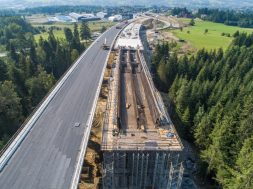How green buildings really bettered in comparison to conventional buildings. Let’s take a look
Global climate change has become more apparent over the last few decades. Although the pace, extent and concrete outcome is uncertain, the direction of climate change is clear. Most climate experts agree that the humans, at least in part, cause this development. The experts are calling for immediate and far-reaching action to fight global warming and remedy its consequences.
Buildings have a lot to do with our external and internal environment, and have a major impact on both our health and the health of future generations. Due to the benefits, builders are opting for Green buildings over conventional buildings. Are green buildings really better in comparison to conventional buildings? Experts share their opinion over different aspects covering both, green and conventional building.
TechnologyBoth conventional and green buildings look alike from outside, yet regarding type of technology used and benefits rendered, they are poles apart. The main objective of green buildings is to reduce energy and water consumption, recycling of waste, using eco-friendly materials, etc. On the other hand, conventional buildings are typically not designed from the point of view of energy, water, material and indoor environment efficiency.
According to Rumi Engineer, Business Head, Green Building Consultancy Services Godrej & Boyce Ltd, “Primarily, there aren’t much differences in technologies used for construction of green buildings. The same set of technologies is used to build a green as well as non-green building. But when it comes to design, we employ special software to simulate the energy consumption patterns, day light availability and artificial lighting for a green building. These are called Building Simulation services. It helps the project team in selecting building materials for wall and roof, fenestration and electrical and lighting equipment based on their impact on the energy consumption.”
Pankaj Kaushal, Vice President- Architecture, REPL says, “By adopting Green buildings one can contribute in reducing carbon foot print.” Building materials which consume less energy are used in green buildings like AAC (Autoclaved Aerated Concrete) blocks or Cellular Concrete blocks or cavity walls using rigid insulation using fly ash bricks which have low density and are light weight. Whereas conventional buildings have 9-inch (230 mm) brick wall or 8-inch (200 mm) concrete block wall.
He further added, “When it comes to electricity and lighting, conventional buildings have typical design standards and lighting power in green buildings significantly reduces to less than 8W per qm”
Mala Singh, Chairman and MD, PEC Greening India Group states, “Green building uses sustainable technologies like rain water harvesting, water efficient plumbing fixtures, recycling of wastewater and Reuse etc. which conserves precious water resource. Use of energy efficient lighting, optimised building envelope, green roof technology, energy efficient equipment and technologies like 3-Star or 5-Star labelled products and use of green energy like solar or any other mean are appropriate strategies for energy conservation in green building.”
Environmental ImpactIn comparison to conventional buildings, green buildings are more energy efficient, have lower operating and maintenance costs, provide better comfort and well-being for occupants, have lower risk potential and reduce negative impact on the environment. A green building is one which represents the most efficient and least disruptive way of using land, water and energy resources while ensuring the healthiest possible environment for the occupants.According to Ms Singh, “Green buildings use key resources like energy, water, materials, and land more efficiently than conventional buildings, thus reducing the prevalent impact created upon environment by conventional construction till date. Conventional buildings don’t incorporate these efficient strategies to reduce the impact upon environment. So sometimes, the conventional methods of design and construction leads to exploitation of natural resources, increased wastage, increased operational and maintenance costs etc.”
Mr Engineer observes, “With regard to impact on the environment, Green buildings lower air pollutant and CO2 emissions by optimising energy use through energy-efficient design, use of renewable energy, and building commissioning. Having more recycled content in the building materials procured for a green building project reduces strain on natural resources e.g. use of hazardous fly ash discarded from power plants in manufacturing of cement.”
He further added, “Erosion and sedimentation control techniques used during and post construction prevent loss of fertile soil and clogging of storm water drains in green building projects. Light pollution can be reduced by banning upward facing lights from the building, thereby protecting the nocturnal habitat of the surrounding area.”
“The importance of how buildings are designed, built and managed is recognised as being able to influence the negative impact of the built environment. Contributing up to 40 per cent of CO2 emissions, 40 per cent of energy consumption, 16 per cent of water usage, 30 per cent of solid landfill waste and 40 per cent of raw materials consumption, buildings have a major impact on climate change,” says Mr Kaushal.He further adds, “A green home uses less energy, produces less waste and uses earth friendly materials in its construction. From utilising reclaimed timber to recycling rain water to using less water and energy to making less construction waste, a green home leaves a far littler footprint on the environment than a historically built home.”
Construction costThe rise in green building is not only because of increased environmental awareness, but also because of serious cost benefits. Green building materials and energy efficient equipment may cost more and add a green premium to building costs, but such items pay for themselves through energy savings, increased home comfort and reduced maintenance costs.
Mr Kaushal states, “A study done by California’s Sustainable Building Task Force of 33 Green buildings found an average of 2 per cent construction cost premium associated with certification. However, it also concluded that the minimal increase in upfront costs; mainly attributed to design, would on average; result in 20 per cent savings of total construction costs over the life cycle of the building, Kats et al., (2003). For a builder point of view, the initial additional cost of 2 per cent can be recovered by the end user because ultimately they are going to get benefitted in the longer run.”
By offering green homes, many builders are now meeting their customers’ needs for energy- and water-efficient homes with a healthier environment and financial benefits.
However Ms Singh feels conventional buildings are more costly, she says, “The conventional ways of construction are more expensive and full of risks like resource wastage, increased energy consumption, inadequate waste disposal etc. leading to more hazards. Green concept uses a well-defined and sustainable approach, which leads to minimal wastage of materials, natural resource conservation by recycling and reuse.”
She further adds, “Unlike conventional buildings, Green buildings adopt strategies with respect to energy, water etc. which helps to avoid over designing the MEP system, which considerably reduces the resource usage, space requirement and construction costs in Green buildings. Hence, conventional buildings are more expensive than green buildings.”
SustainabilityCompared to Conventional buildings, Green building is built upon the principles of environmental, social and economical sustainability by adopting a holistic approach from planning level itself.
Mr Engineer opines, “To sustain the energy and water efficiency measures adopted in a newly constructed building one needs to maintain them. There are Green Building rating systems available in India from USGBC and IGBC that cater to operations and maintenance of existing buildings, both conventional as well as green. By adopting green practices for operations and maintenance, one may easily sustain the green building features adopted during the construction.”
The expression green building and sustainable building are often used interchangeably, though these terms can have different meanings too. Green buildings can be expected to consume less energy and thus consequently generate lower CO2 emissions.
Mr Kaushal says, “Compared to conventional buildings, green buildings have low environmental impact throughout the various phases of a buildings’ life cycle, that is ; from siting to design, construction, operation, maintenance, renovation, and demolition and offers better health and wellbeing for occupants. Hence, they are more sustainable.”
The end result is a product which is indeed sustainable and environment conscious in nature, having universally accessible design, consuming significantly less energy and water, generating less waste and having improved quality of life.
Green buildings encourages recycling and reuse of resources which finally leads to conserving natural resources, reduce carbon footprint and helps to mitigate impacts of global warming and greenhouse gas emissions. Green buildings help to reduce energy consumption up to 30 – 40 per cent and water savings up to 50 – 60 per cent, all of which is reflected as reduction in electricity bills and reduced water tariffs.
“Sometimes, an efficient way of using green energy like solar, can help to reduce the total energy costs from conventional electricity. These projects can sustain on its own energy generation for the whole lifecycle of the project,” concludes Ms Singh.
——————————Green concept uses a well-defined and sustainable approach, which leads to minimal wastage of materials, natural resource conservation by recycling and reuse.
Mala Singh, Chairman and MD, PEC Greening India Group——————————
——————————By adopting green practices for operations and maintenance, one may easily sustain the green building features adopted during the construction.
Rumi Engineer, Business Head, Green Building Consultancy Services, Godrej & Boyce Ltd——————————-
———————————Compared to conventional buildings, green buildings have low environmental impact throughout the various phases of a buildings’ life cycle
Pankaj Kaushal, Vice President- Architecture, REPL——————————–
Cookie Consent
We use cookies to personalize your experience. By continuing to visit this website you agree to our Terms & Conditions, Privacy Policy and Cookie Policy.









